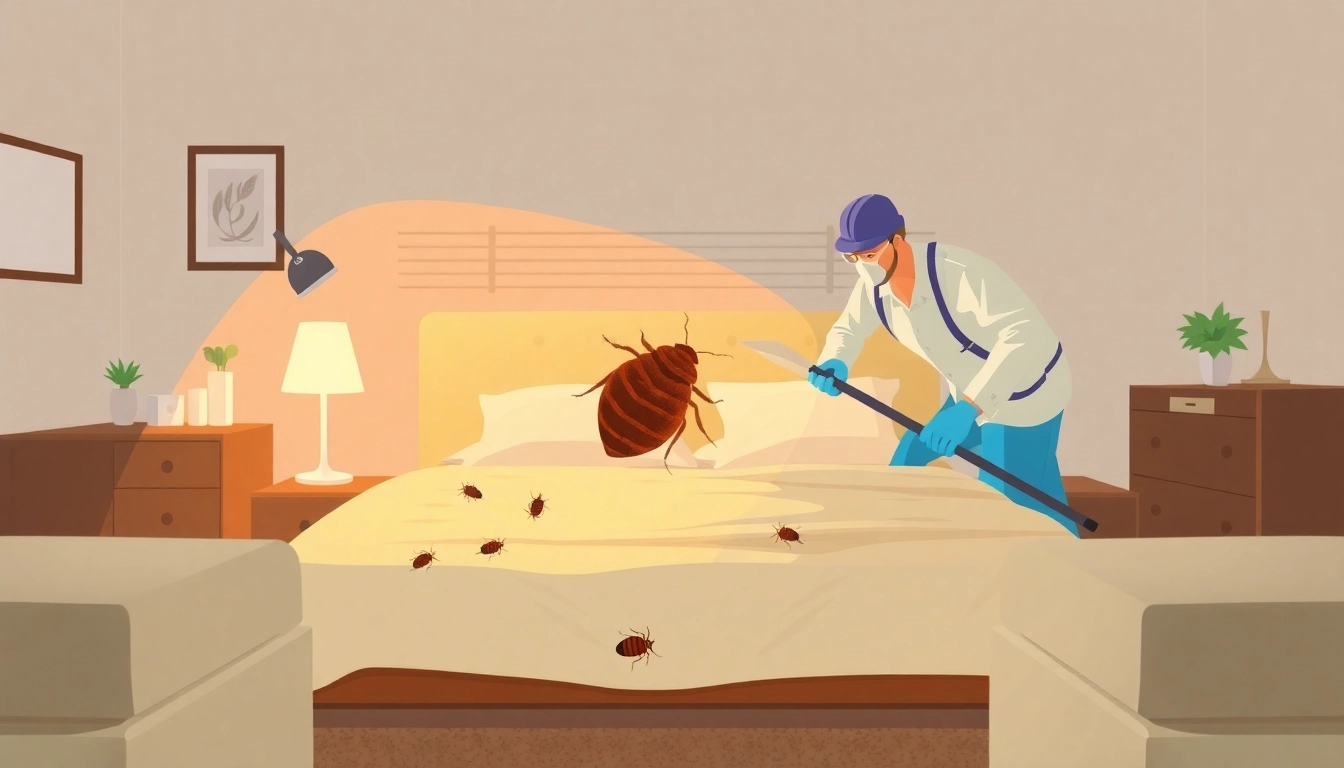Understanding Bed Bug Infestations
What are Bed Bugs?
Bed bugs, scientifically known as Cimex lectularius, are small, parasitic insects that feed primarily on human blood. Adults are typically about the size of an apple seed—ranging from 4 to 5 mm in length—and possess flat, oval bodies that allow them to hide in narrow spaces during the day. Bed bugs are nocturnal, making them most active at night when they seek out weakened hosts to feed on unsuspecting sleepers. Despite their name, they can be found anywhere humans and animals gather.
Signs of a Bed Bug Problem
Recognizing a bed bug infestation early is crucial for effective bed bug removal. Common signs include:
- Bed Bug Bites: Small, red, itchy welts often appearing in clusters on exposed skin—especially around the arms, neck, and face.
- Blood Stains: Tiny red or brown spots on bed linens or pillows are remnants of crushed bugs or blood from bites.
- Dark Spots: Fecal matter appears as dark brown or black spots in areas where bed bugs hide.
- Eggs and Shells: Tiny, translucent eggs and discarded exoskeletons indicate a multiplying population.
Common Misconceptions About Bed Bugs
There are several misconceptions surrounding bed bugs that can impede effective control and prevention:
- Only Poor Hygiene Attracts Bed Bugs: Bed bugs can infest any location regardless of cleanliness, thriving in hotels, apartments, homes, and public transportation.
- Bites are Just Allergies: Many mistakenly believe bites won’t affect them. Reactions can vary, but pronounced allergic responses can occur leading to uncomfortable symptoms.
- Heat Kills Bed Bugs Instantly: While high temperatures are effective, proper techniques are essential to ensure all life stages—eggs included—are eradicated.
Preparing for Bed Bug Removal
Initial Steps to Take
Preparation is critical for effective bed bug removal. Start by following these steps:
- Confirm the Infestation: It’s essential to positively identify bed bugs before treating your home to avoid unnecessary treatments.
- Inform Household Members: Notify everyone living in the environment about the infestation to ensure cooperation and minimize spreading.
- Contain the Problem: Avoid moving items from the infested area to prevent spreading bed bugs to other rooms.
Importance of Decluttering
Before treatment, decluttering is crucial. Reducing the number of items in an area minimizes bed bug hiding spots and makes the removal process more efficient. Consider the following tips:
- Sort Items: Evaluate each item in the infested area. Discard any unnecessary items that may be harboring bed bugs.
- Seal Items: Use airtight bags to store clothing and personal items temporarily while addressing the infestation.
- Inspect Other Areas: Check adjacent rooms and common areas, as bed bugs can travel through walls and plumbing.
Creating a Bed Bug Treatment Plan
Developing a comprehensive bed bug treatment plan is essential for successful eradication. Key components include:
- Choosing Treatment Methods: Consider your options, including chemical treatments, heat treatments, or DIY solutions based on severity and personal preference.
- Setting a Timeline: Implement a timeline for each phase of the treatment to ensure thorough and consistent action.
- Monitoring Progress: After initial treatments, set intervals for follow-up inspections to determine if additional treatments are needed.
Bed Bug Removal Techniques
Chemical vs. Non-Chemical Solutions
When it comes to bed bug removal, understanding the difference between chemical and non-chemical solutions is crucial:
- Chemical Solutions: Insecticides specifically formulated to target bed bugs can effectively eliminate infestations but must be applied carefully and according to safety guidelines. Popular chemical solutions include pyrethroids and neonicotinoids.
- Non-Chemical Solutions: These include methods such as high-heat treatment, steam cleaning, and essential oil sprays. Non-chemical treatments are often safer to use in homes with children or pets and can be very effective.
Step-by-Step Guide to DIY Bed Bug Removal
Homeowners may choose to tackle bed bugs without professional help. Here’s a DIY approach to removing bed bugs:
- Wash and Dry Fabrics: Clean all bed linens, curtains, and clothing in hot water (at least 120°F/49°C) and dry on high heat for at least 30 minutes.
- Vacuum Thoroughly: Use a vacuum with a HEPA filter to systematically vacuum all infested areas, including carpets, furniture, and edges of the bed.
- Use Steam Treatment: Utilize a steam cleaner on mattresses, furniture, and cracks. Ensure the temperature reaches at least 130°F (54°C) to kill bed bugs and their eggs.
- Apply Diatomaceous Earth: Sprinkle food-grade diatomaceous earth in cracks and crevices to dehydrate and kill bed bugs. This solution is especially useful for hard-to-reach spaces.
Professional vs. Home Solutions
Determining whether to rely on professional services or to DIY can depend on infestation severity, budget, and time constraints:
- Professional Solutions: Pest control experts often utilize specialized equipment and pesticides, as well as offer warranties for product effectiveness, making them ideal for more extensive infestations.
- Home Solutions: If the infestation is minor, a rigorous DIY approach may suffice, allowing homeowners to save money while still effectively tackling the problem.
Aftercare: Preventing Future Infestations
Post-Treatment Cleaning Tips
After the initial removal process, cleanliness is vital. Here are some important cleaning tips:
- Continue Regular Vacuuming: Maintain a rigorous vacuuming schedule to capture any missed bed bugs.
- Wash Bedding Periodically: Continue to wash and heat-dry bed linens regularly to ensure that any new insects are eradicated before they can multiply.
- Keep Clutter to a Minimum: Clutter not only provides hiding spots for bed bugs but also makes cleaning and monitoring more difficult.
Long-Term Prevention Strategies
Preventing re-infestation requires diligence and awareness. Various measures can help:
- Bed Bug Covers: Use protective mattress and box spring covers designed to contain bed bugs and prevent new infestations.
- Regular Inspections: Periodically check furniture, luggage, and areas most susceptible to bed bugs, particularly after travel.
- Education: Stay informed about bed bugs and their habits to effectively detect signs and prevent future issues.
Monitoring for Re-infestation
Implement monitoring strategies to catch potential re-infestations early:
- Bed Bug Monitors: Set up bed bug monitors outlined in traps to see if any bugs are present.
- Host Surveys: Conduct regular surveys of guests or new items entering your home that could potentially harbor bed bugs.
- Professional Inspections: Consider scheduled inspections by pest control experts to ensure bed bug-free living conditions.
Cost and Resources for Bed Bug Removal
Understanding the Costs Involved
The costs of bed bug treatment can vary significantly based on the extent of the infestation, treatment type, and geographical location. The average treatment cost typically ranges from $200 to $2,500:
- DIY Methods: Costs are generally lower, averaging between $50 to $200 if using home solutions like vacuuming, washing, and steam cleaning.
- Professional Treatments: These services can cost between $500 and $1,500, covering inspection and multiple treatments if necessary.
- Follow-up Treatments: It’s essential to factor in potential follow-up treatments, which can cost additional fees, especially if any larvae or eggs remain.
Finding Affordable Bed Bug Extermination Services
Finding the right extermination service at an affordable rate can be challenging. Consider these steps:
- Research Local Services: Look for pest control companies in your area, checking online reviews and ratings.
- Get Multiple Quotes: Contact different exterminators to compare prices and services included to ensure value.
- Ask About Packages: Many companies offer packages that might include discounts for multiple treatments or combined pest solutions.
Community Resources and Assistance Programs
Some communities offer assistance programs for those struggling with pest control costs. Check for:
- Local Health Departments: They may have information on community resources and programs aimed at addressing infestations.
- Non-Profit Organizations: These can sometimes provide assistance or direct you to low-cost pest solutions.
- Online Forums and Groups: Join online communities for advice or recommendations for affordable pest treatment services.




